7 ways to get grade-schoolers on a school sleep schedule
To do their best in school, grade-schoolers need a good night’s sleep — 10 to 11 hours. Kids’ sleep schedules often get derailed, though, by winter or summer break or by a change at home. Here are ways to get back on track.
 1. Adjust wake-up time in stages.
1. Adjust wake-up time in stages.
If your child has been sleeping in two hours past school wake-up time, don’t try to change all at once. Start by getting your child up an hour earlier for a few days. Then gradually wake your child up earlier and earlier.
2. Gradually move up bedtime.
Again, adjust your child’s schedule in stages. If your child is getting up an hour earlier, make bedtime an hour earlier, too, and so on.
3. Make sure your child gets exercise.
Being physically active throughout the day will help your child sleep at night. But try to avoid exercise in the three hours before bedtime.
4. Try to keep your child awake all afternoon.
Do chores, play outside, plan together time. Try not to let school-age kids crash during the day, or they may be wide awake at bedtime.
5. Phase out electronics one hour before bedtime.
Electronic devices like video games, televisions, and computers can prevent kids from winding down. The light and noise can be distracting and tempt kids to want to play instead of getting ready for sleep. If your child has or uses electronic devices, try to turn them off an hour before bedtime.
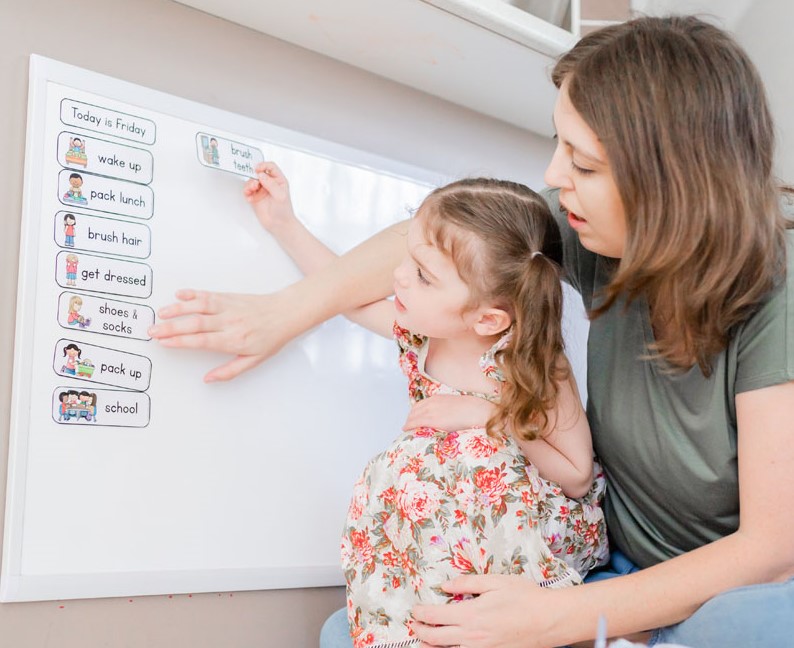 6. Establish a bedtime routine.
6. Establish a bedtime routine.
Putting on pajamas, brushing teeth, and reading a story together can help kids prepare for sleep. If your child has trouble with routines, try using a bedtime checklist.
Does your child’s bedtime routine seem to take forever? Do you feel like you have to drag your child through every step?
Bedtime routines are really frustrating for lots of families. You may wonder why your child refuses to wind down. But for some kids, it’s not about avoiding going to bed. They might be having trouble remembering and following the steps to get there.
That’s where a bedtime checklist comes in. Routine Charts and Checklists can help kids keep track of and follow a routine. A checklist shows them what they need to do before calling it a night. It also helps them remember the order to do things in.
Download a checklist to help your child follow nighttime routines. One is a bedtime checklist for younger kids who need more guidance. The other is a nighttime checklist for older kids who are a little more independent.
You could even laminate your checklist and give your child a dry-erase marker to mark things off as they go.
7. Create a sleep-friendly environment.
Turn off the lights, shut the blinds, and keep the temperature cool. And be sure to keep any electronic devices out of the bedroom. Place them in a common area, like the living room. Remember, it's common for kids with differences like ADHD to have trouble with sleeping.
My simple solve for chaotic mornings
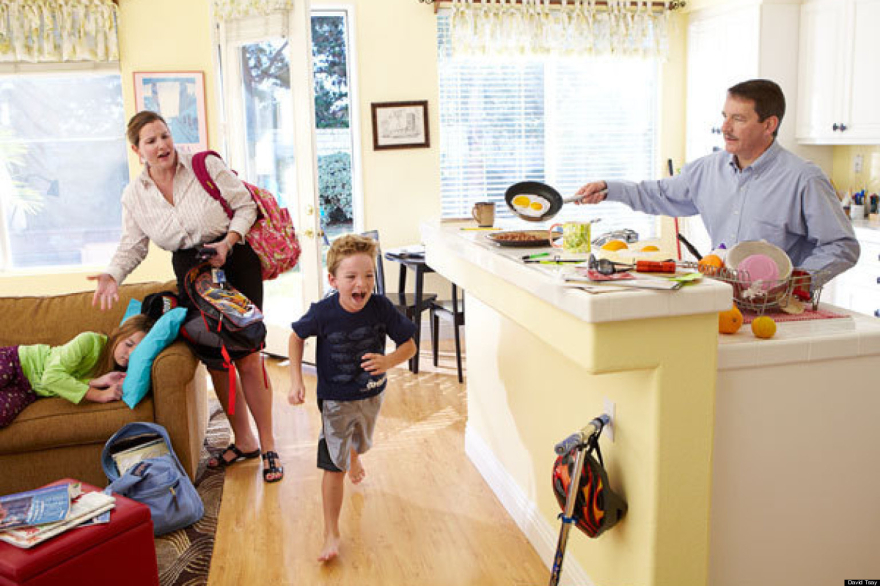 My story
My story
For years, school mornings with 2 boys were the bane of my existence. My younger child has ADHD and has always had trouble with organization, planning and time maintenance. He also tends to be very emotional and resistant to transitions.
After years of frustration, I finally realized I’d been doing the same old thing during these hectic mornings and I needed to change my approach.
What I was doing
Like a lot of kids with learning differences, my son doesn’t leap out of bed eager to get ready for school. Our morning routine had always been rushed and manic. It went something like this:
“Good morning kiddo. We need to get ready for school — wait, why are you putting your coat on?”
“Yes, I said we’re getting ready for school, but you still have your pajamas on. Please get dressed.”
“Hold on, you have to take the pajamas off before you put the clothes on.”
“Buddy, why are you going to the bathtub? I know you don’t have clothes on. But it’s not bath time. It’s time for school!”
Sometimes I’d spend the whole morning just trying to get him dressed. That left only a minute or two to throw him some toast in the backseat of the car for breakfast. And forget about my getting to work on time.
What I wish I’d known sooner
 I’ve been giving him reminders, but that’s not what he needed. He needed a strategy for organizing his routine.
I’ve been giving him reminders, but that’s not what he needed. He needed a strategy for organizing his routine.
So I searched for ideas. As it turned out, the solution was fairly simple. Two tips popped up that seemed promising: figuring out what was causing schedule problems and making a routine chart. I liked the idea of a routine chart, because spoken instructions can be a struggle for my son. But I also thought that trying to pinpoint the problem first would help me figure out a solution. Of course, “pinpointing the problem” is easier said than done. It’s really tough to step back and just observe your child— especially when you’re trying to get out the door in the morning. Then I had an idea. I decided to do a normal morning routine on a couple of vacation days when I didn’t feel the time pressure to keep us moving along. Here’s what I saw: My son was struggling with the sequence of what he was supposed to do while still waking up. He was groggy and confused about what to do first, second, and so on. Once I saw the problem, I had a better idea of what to do. I shifted my own schedule a little. I started his wake-up process as soon as I got up, instead of waiting until after I had showered and dressed. By waking him earlier, I was able to give him a “soft start” to the morning. I also used photos to make a picture schedule to help him know what he needed to do each morning, and in what order. Mornings are a lot less manic now. I have time to get ready and make a real breakfast while my son makes his way through his schedule. We can both leave ready for the day without feeling so rushed. And you know what? He’s a lot happier that he’s getting more than just toast for breakfast.
8 ways to make school morning routines easier
No one likes rushing around in the morning. And for families with kids who learn and think differently, the dash from morning wake-up to leaving for school can be extra stressful. Your child might have trouble following a schedule, finding things, or coping with a jarring alarm clock. Try these tips to streamline school morning routines.
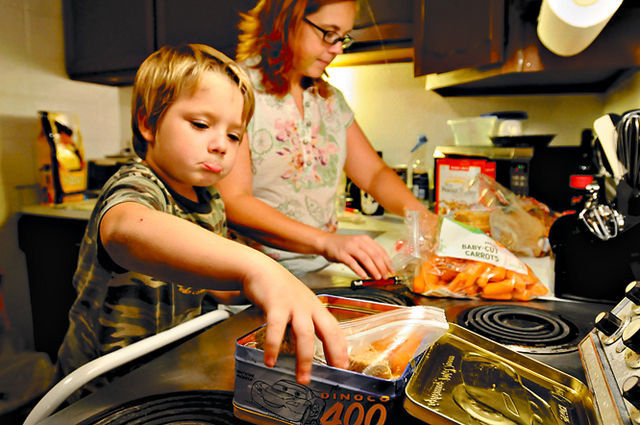 1. Start the night before.
1. Start the night before.
To jump-start the morning routine, plan ahead. Before bedtime, have your child get a bath or shower out of the way. Then, ask your child to pick out an outfit for the next day. Take a few minutes to go over the next day’s schedule together. Check that all books, homework, and changes of clothing are packed up and by the door.
2. Give yourself time in the morning.
If your child needs more time to manage the morning routine, it makes sense that you will, too. Wake up a little earlier than your child. Give yourself enough time to eat breakfast, drink coffee, exercise, or do whatever helps you get in the zone for the day.
Leave plenty of time to help your child get ready. Try not to be racing around to get yourself ready at the same time. This will lower the stress level for both of you.
 3. Make wake-ups more relaxing.
3. Make wake-ups more relaxing.
How can you make early mornings less of a rude awakening? Loud alarms can be jarring and start the morning with an unneeded jolt (especially for kids with sensory challenges).
Set your child’s alarm to play a favorite song. Try waking your child up with lots of snuggles or a favorite breakfast. A more pleasant wake-up doesn’t mean it has to be longer.
4. Follow a routine.
Make every day as predictable as you can. Follow the same routine before and after school. It can look something like this: Wake up, wash face, eat breakfast, get dressed, brush teeth, go over the day’s schedule, leave for school. A routine chart can be extra helpful for kids who struggle with reading.
5. Stay organized.
Designate spots for school supplies, sports gear, coats, and jackets. This way, your child always knows where to look for things when you’re halfway out the door. Plastic containers or labeled baskets can keep items within easy view, which makes it simpler to look for things in the morning.
6. Stick with the clock.
Make sure there are clocks “in your face” around the house. Put them in your child’s room, the bathroom, the kitchen — even the hallway. Older kids can also wear a watch. By making time more visible, you’ll help teach your child how to manage time. And it’ll make it clear that being on time is important.
Give manageable countdowns, like “At 7:25, it’ll be time to put your shoes on.”
 7. Do a “double-check.”
7. Do a “double-check.”
Have your child check and re-check to make sure everything’s packed before leaving the house. Younger kids can come up with a silly phrase or song to help remember all the books and materials they need each morning. Older kids can make lists of all the items needed for each day of the week. Post it where your child will see it often. And refer to it before leaving the house.
8. Reward your child.
This is a simple way to help your child get the most out of a smoother morning. For example, if your child gets ready for school and still has time to spare before it’s time to leave, play a quick game together or read a book. Starting the day with some cozy family bonding helps get everyone off to a solid start.
COOL RESOURCE
Routine Charts and Checklists can help kids keep track of and follow a routine. A checklist shows them what they need to do before calling it a night. It also helps them remember the order to do things in.
Download a checklist to help your child follow nighttime routines:
Bedtime Checklist for Younger Kids Nighttime Checklist for Older Kids


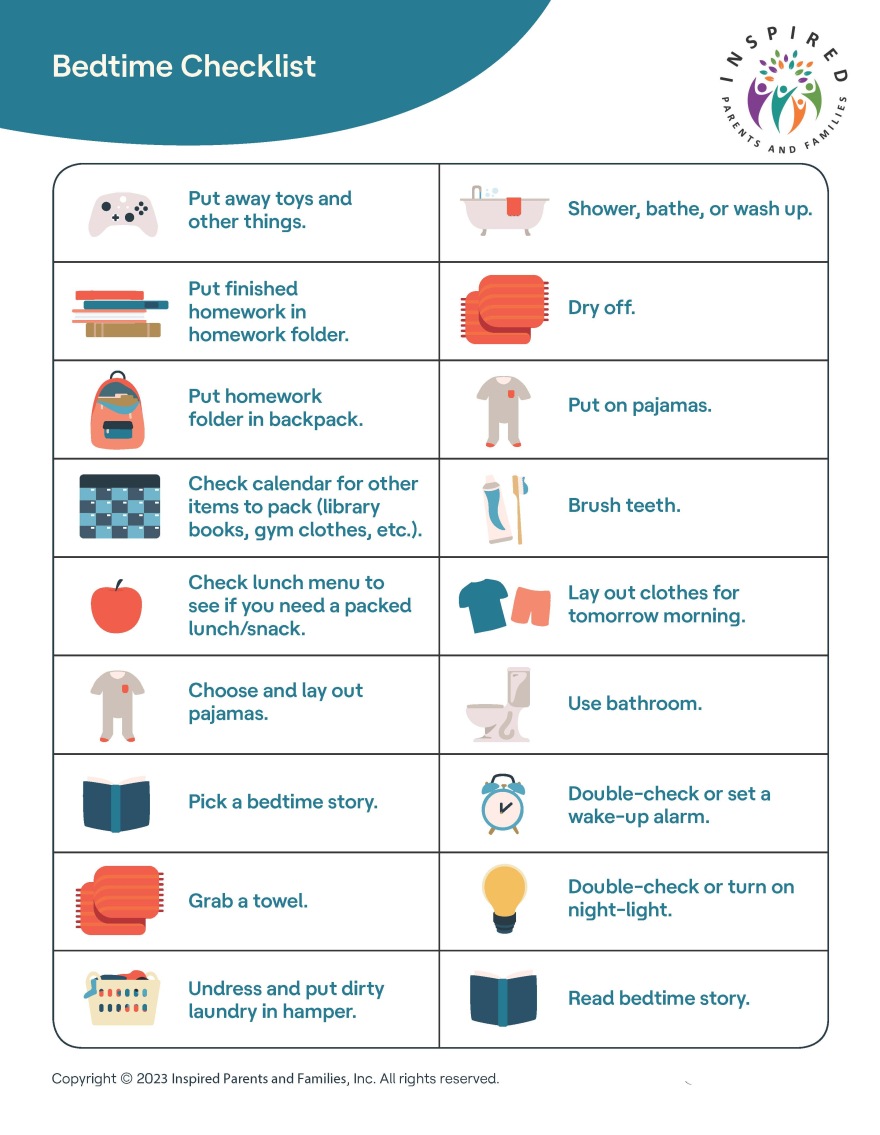
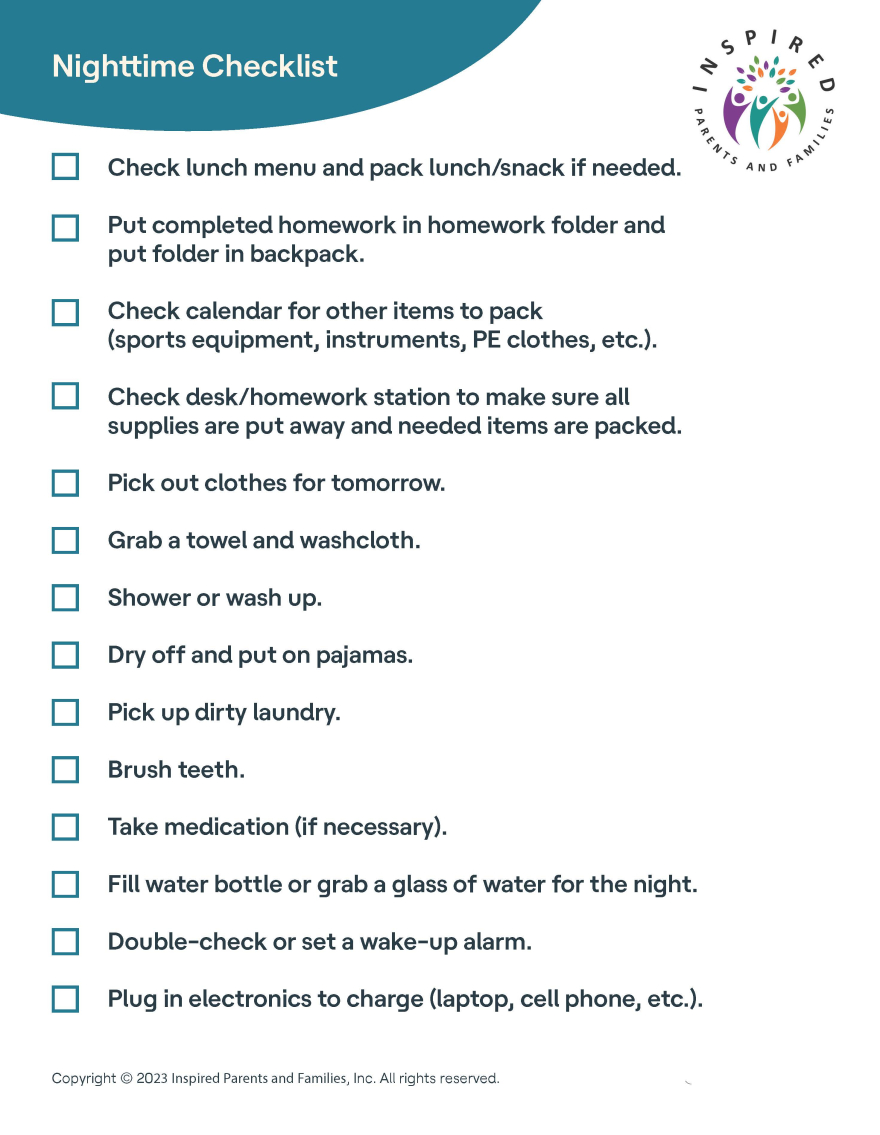


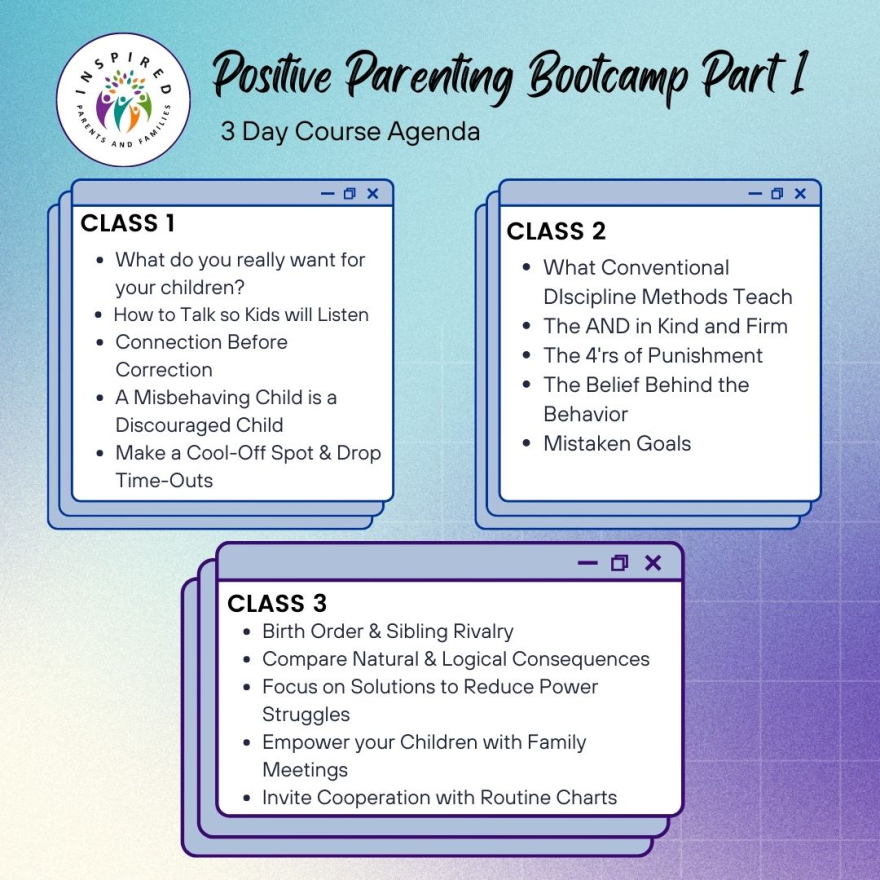 Parents and caregivers will learn long term solutions for raising kids to feel “I am capable, I can contribute, and I can use my personal power in useful ways to improve my life and the lives of others!” Positive Discipline teaches long term parenting skills that will encourage children to think for themselves, become more responsible and have a greater respect for themselves and others. Feel supported while learning some non-punitive, respectful methods that will incorporate kindness and firmness into your relationship with your children. Get to the core of your children's misbehavior, practice encouraging tools and gain a sense of accomplishment.
Parents and caregivers will learn long term solutions for raising kids to feel “I am capable, I can contribute, and I can use my personal power in useful ways to improve my life and the lives of others!” Positive Discipline teaches long term parenting skills that will encourage children to think for themselves, become more responsible and have a greater respect for themselves and others. Feel supported while learning some non-punitive, respectful methods that will incorporate kindness and firmness into your relationship with your children. Get to the core of your children's misbehavior, practice encouraging tools and gain a sense of accomplishment.
 Parent coaching is designed to provide insight, help parents discover newfound energy in their parenting, develop an appreciation for what they have and who they are, and create sustainable ways to achieve their vision or dream for their family. Different than therapy, coaching’s unique methodology allows the coach to provide support as a cheerleader, guide, and mirror. Coaching is perfect for helping parents who are feeling overwhelmed, parents who are baffled by their children’s behavior, parents who are looking to bolster their parenting “tool box,” and parents who simply want to take their family’s life from good to great. Interested to see if Coaching would be a good fit for your family? Click below to schedule a complimentary discovery call.
Parent coaching is designed to provide insight, help parents discover newfound energy in their parenting, develop an appreciation for what they have and who they are, and create sustainable ways to achieve their vision or dream for their family. Different than therapy, coaching’s unique methodology allows the coach to provide support as a cheerleader, guide, and mirror. Coaching is perfect for helping parents who are feeling overwhelmed, parents who are baffled by their children’s behavior, parents who are looking to bolster their parenting “tool box,” and parents who simply want to take their family’s life from good to great. Interested to see if Coaching would be a good fit for your family? Click below to schedule a complimentary discovery call.